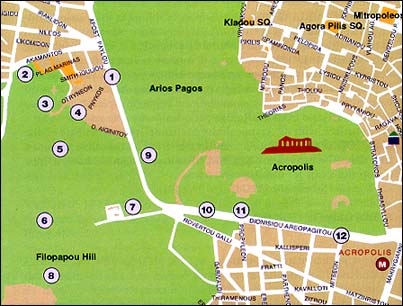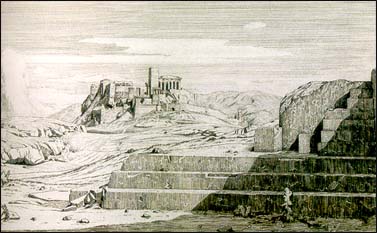|
Special Feature:
Heritage Walks in Athens |
|
2nd
HERITAGE WALK:
HILLS AND DEMES (MUNICIPALITIES) OF ANCIENT
ATHENS |
 (Continued from
March's Issue) (Continued from
March's Issue)
STARTING POINT: Thisio Station
TERMINUS:
Acropolis Station.
The 2nd walk does not involve visiting any
museums, and thus is ideal for late
afternoon
and early evening hours. The views of the
Acropolis from various spots on the Hill of
Philopappou are superb.
(1) Pedestrian Area
of Apostolou Pavlou
Street
This is the "Great Peripatos" or walk of
modern Athenian history, the most ambitious
civic planning project carried out in Athens
during the last decades, aimed at promoting
the ancient history of the city. This
pedestrian area unites the major
archaeological sites of Athens: the
Kerameikos, the
ancient Agora, the Hill of the Nymphs (Pnyx)
and the Hill of the Muses (Philopappou), the
Areopagus, the Acropolis, the Theatre of
Dionysus, and the Parilissian area (the
Olympieion). At the same time, it
incorporates some popular venues, such as
the Odeion of
Herodes Atticus and the Acropolis Museum
(still under construction).
The original plan by the architects
Cleanthis and Schaubert dates from 1833, and
was
approved shortly after, but was not
implemented. Towards the end of the 20"
century, it was
supported by the town planner Antonis
Tritsis, for a time Mayor of Athens, and was
finally
implemented at the beginning of the 3 d
millennium.
The "peripatos" was created by the
organization for the Unification of the
Archeological
Sites of Athens (EAXA), and has been
embraced by the citizens of Athens. It is a
popular
spot for young and old to come and enjoy a
quiet stroll under the sacred rock of the
Acropolis, undisturbed by traffic.
We leave the pedestrian area, turning on
Dimitriou Aiginitou Street and climb our way
up to the
Observatory. After our visit to the
Nymphs'Hill (Pnyx) and the Muses' Hill (Philopappos),
we will continue our walk along this
pedestrian area. From Dimitriou Aiginitou St
we can
also directly enter the Pnyx.
(2) Observatory
Built on the Hill of the Nymphs with a
donation by George Sinas, and
designed by Theophilos Hansen, it was opened
on June 26'",1842, a day when there was a
solar eclipse. Upon seeing the finished
structure, the architect was immensely
impressed,
and left an inscription on the building: "Servare
Intaminatum" (to be kept intact). Today,
in the same area, one can see also the
Seismological Institute.
Northwest of the Observatory, near the site
of the large church of Saint Marina, one can
see the remains of a small older church
(also dedicated to the same Saint) that
dates from
the "dark centuries" (8t' to 9`h century).
Traces of the Sanctuary to Zeus Ypsistos
were found on a nearby spot, which offers a
panoramic view. On a somewhat lower level,
the "kylistra" or "tsouliastra" was traced,
where, in ancient time Athenian women who
had difficulty in bearing children used to
come
and slide down. (tel.: 210 3490101, 3490102)
(3) Ancient Deme
(Municipality) of Meliti
Situated between the Agoraios Kolonos, the
Areopagos and the Pnyx, which was once part
of the Deme. Meliti and the neighboring deme
of
Koili were major demes of classical times.
(4) Hill Of The Nymphs - Pnyx
A 105m-high
hill that looks like an extension of the
Hill of
the Muses. From the end of the 6" century
BC, it gradually came to be the official
location
for the meetings of the Athenian popular
assembly.
From early antiquity on, this was a site
sacred to the Nymphs. Strangely enough, the
Nymphs
never lost their place in popular legend,
unlike the gods of Olympus that Christianity
displaced. According to legend, the Nymphs
are masters of nature, and also can master
the
souls, and even the minds of mortals. People
are no longer described as captured by the
Nymphs (the ancient "Nymphopliktoi"), but by
the fairies!...
The Pnyx, site of the Athenian popular
assembly, initially was an amphitheatre
facing the
Acropolis. Since people attending the
Assembly were admiring the monuments on the
Sacred
Rock or maybe (according to Aristophanes)
were just sitting there, watching the agora
and
reflecting on lost earnings and did not pay
due attention to the speakers, in 404-3 BC
it
was turned the other way around. In
addition, the semicircle was expanded, and a
retaining
wall was built, as well as side tiers. In the period of Lykourgos (330-326 BC), the
Pynx developed into its current form. The
speakers' podium was carved out of the
natural rock and, beside it, one can still
see the
carved niches for the votive gifts to Zeus
Ypsistos. It is believed that higher than
the
speakers platform stood the sacrificial
altar of Zeus Agoraios, which was later
transferred
to the Agora. Meton's sundial was situated
to the southwest of the podium.
Around the end of the 4" century BC, the (no
longer democratic) Athenian popular assembly
moved to the Theatre of Dionysus. The Hill
of the Nymphs was adjoined to the
neighboring
Hill of the Muses (Philopappou) by an "arm"
of the fortified city walls, known as
"diateihisma".
(5) Ancient Fortifications
In the last
quarter of the 4" century BC, on the ridges
of the
hills and in-between the Hill of the Nymphs
and the Hill of Philopappou, a new wall was
built, namely the diateihisma. Also
constructed at the same time, and to the
northwest of
the diateihisma, were the Gates of Meliti,
that lead in to Meliti, and the "Dipylon
over
the Gates", visible on the street close to
the Church of Aghios Dimitrios Loumbardiaris.
(6) Ancient Deme Of Koili
This began from
the Pnyx but, on the outer side of the later
diateihisma, and extended to the southwest
of the hill.
Until the 4" century BC, it was one of the
most densely populated areas in ancient
Athens.
After the diateihisma was built (last
quarter of the 4" century BC), it was
gradually
abandoned. By the beginning of the 2"d
century BC, the whole area had turned into a
huge
cemetery.
(7) Church of Aphios Dimitrios Loumbardiaris
A 15" century barrel vaulted single
aisled
basilica, restored by the architect Dimitris
Pikionis in1955. It preserves murals that
date from 1735.
(8) Hill of the Muses - Philopappou
An
imposing 147m-high hill situated to the
southeast
of the Acropolis, once used as a sanctuary
to the Muses (Mouseion). On top of the hill,
one
can still see the foundations for the
surrounding fortifying wall that date from
294 BC,
built by Dimitrios the Besieger to instal
his guards.
 Later, in Roman times (115 AD),
the
City gave permission for a burial monument
to be erected here in honor of Philopappos,
a
descendant of the Seleucides. It is an
interesting example of the architecture and
sculpture of the period. In 1954-1957, the
architect and thinker Dimitris Pikionis
formed a
wonderful area for viewing the Acropolis
from the hill of Philopappou. He also
created the
approach pathways to the Acropolis, the
Areopagus and the Hills of the Nymphs and of
the
Muses. The pathways are an artistic
achievement in themselves and the planting
around them
sensitive. Dimitris Pikionis was a major
figure in the history of Greek architecture
who
drew on Greek tradition but was also
influenced by the simplicity of Japanese
aesthetics.
His desire was that the hill of Philopapppos
should remain freely accessible alike to
Athenians and visitors, as indeed it is up
to today. Later, in Roman times (115 AD),
the
City gave permission for a burial monument
to be erected here in honor of Philopappos,
a
descendant of the Seleucides. It is an
interesting example of the architecture and
sculpture of the period. In 1954-1957, the
architect and thinker Dimitris Pikionis
formed a
wonderful area for viewing the Acropolis
from the hill of Philopappou. He also
created the
approach pathways to the Acropolis, the
Areopagus and the Hills of the Nymphs and of
the
Muses. The pathways are an artistic
achievement in themselves and the planting
around them
sensitive. Dimitris Pikionis was a major
figure in the history of Greek architecture
who
drew on Greek tradition but was also
influenced by the simplicity of Japanese
aesthetics.
His desire was that the hill of Philopapppos
should remain freely accessible alike to
Athenians and visitors, as indeed it is up
to today.
(9) Ancient Deme of Colyttos
At the meeting
point of the Apostolou Pavlou and Dionysiou
Areopagitou pedestrian areas with the
cobblestoned paths of the architect Dimitris
Pikionis
that lead to Philopappou and the Acropolis
respectively and, east of Apostolou Pavlou
Street,
we may admire the ancient street of this
Deme, architectural remains from the
classical
period and late antiquity, houses, and
sanctuaries. Noteworthy are the Sanctuary of
Dionysus, the "Vakcheion" (2"d century AD)
and the "Amyneion" (very similar to the
Asclepion), dedicated to Amynos, a doctor -
hero.
(10) Dionysiou Areopagitou Pedestrian Area
The second part of the "Great Peripatos"
under
the Acropolis.
Theater of Herodes Atticus (see
Heritage
Walk #1)
(11) Sanctuary of the Nymph
Situated in
front of the Herodes Atticus Theatre, below
and
next to the pedestrian area level. Numerous
offerings were found inside the sanctuary,
mostly loutroforoi, par excellence vases for
the marriage ceremony. Most probably, these
were votive gifts by the virgins of Athens,
who wished the favour of the Nymphs in order
to
achieve happiness in their marriage. Some
say that the sanctuary was associated with
the
cult of Ersi, an Athenian princess and
daughter of Cecrops, and the Nymph of dew
and
greenery, of marriage and offspring.
Alternately it may have been associated with
the cult
of the goddess Aphrodite, that replaced the
cult of Ersi.
(12) The Spanish Embassy
Housed in a
mansion built by the architect Ernest Ziller
at the
beginning of the 20" century.
(21 Areopagitou St, tel.: 210 9213123)
Up on Thrasyllou
Street - and continue to the
right on Vakchou Street, Vyronos
Street, and Shelley Street, and Tripodon Street, which lie exactly over the ancient Tripodon
Street.
Lysicrates' Monument (see
Heritage Walk #1)
Elliniki Etairia (see
Heritage Walk #1)
(M) Acropolis
Station
Excerpt from: "Heritage Walks in Athens"
by the Municipality of Athens Cultural
Organization,
and by the Elliniki Etairia Hellenic Society
for the Protection of the Environment and
the Cultural Heritage
Next
Month's Article:
Heritage Walk #3: Agora and Areopagos - The Heart of
Ancient Athens
|

